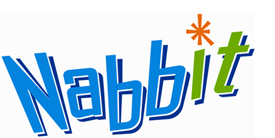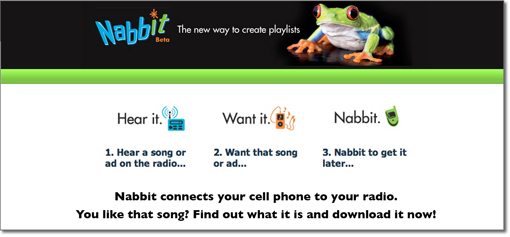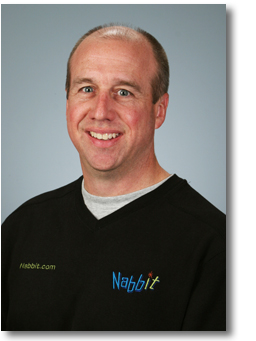 On May 13th a press release announced the new partnership between Eagan-based Jump Technologies’ Nabbit service and CBS Radio, Minneapolis (102.9 Lite FM, 104.1 Jack FM, 830 WCCO AM). This partnership will further move Nabbit from a relatively simple tagging application into a full blown marketing tool. On that day, the eve of the big rollout of said partnership, I sat down with Nabbit chief (“Chief Nabber” on the business card), John Freund, to talk about the Nabbit, where it started, where it is and where it’s going.
On May 13th a press release announced the new partnership between Eagan-based Jump Technologies’ Nabbit service and CBS Radio, Minneapolis (102.9 Lite FM, 104.1 Jack FM, 830 WCCO AM). This partnership will further move Nabbit from a relatively simple tagging application into a full blown marketing tool. On that day, the eve of the big rollout of said partnership, I sat down with Nabbit chief (“Chief Nabber” on the business card), John Freund, to talk about the Nabbit, where it started, where it is and where it’s going.
Nabbit was born some two years ago as Freund and his team at Jump Technologies were discussing the eBay purchase of Skype. “I remember saying how great it would be to have 50 million subscribers to anything.” The discussion included colleague (and radio fan) Norton Lam’s thoughts about tagging radio content. So was the birth of Nabbit. According to Freund, “The first year we dedicated about 10% of Jump Technologies resources to Nabbit.” That has clearly grown as Nabbit has evolved, indicating a great deal of confidence in the potential of the business.
At first, it truly was a “content play” offering listeners of radio the ability to tag songs and advertisements via internet enabled cell phones. Those tagged pieces of content are placed into the Nabbit user’s account for later action including purchase or artist and advertiser info.
“We found that while users were tagging music they were actually tagging more advertising and the calls to action that they provided.” This led to what Nabbit describes as the first service that allows marketers to combine broadcast, mobile, direct response, and online advertising into one integrated consumer marketing campaign.
Here’s how it works.
Once a consumer downloads the free application to their internet enabled mobile phone they assign stations to the buttons on the phone. When they hear something they want to “nabb” they press the button for that station. If it’s an ad, the Nabbit Ad engine springs into action. Not only is a copy of the ad placed in the listener’s account, it can also send a text coupon or place a call to their phone though the Nabbit Callback feature (and it should be noted that all the features are opt-in via the user’s Nabbit account).

This is where Nabbit’s media relationships come in. Freund and Nabbit have been working with radio station KTTB (B96) here in the Twin Cities (CBS isn’t the first). Freund says that the desire for exclusivity by stations was a barrier to getting deals going with the bigger companies. It took plenty of proof, and persuading, the likes of CBS that Nabbit truly needs to be on as many stations as possible in order to be successful.
There are still barriers that Nabbit will face from a revenue generation standpoint. The service is free to consumers so the business model is based on advertising revenue sharing with media partners. According to a quote from the press release on the Nabbit/CBS partnership, CBS VP/GM of CBS Radio in Minneapolis explained, “Nabbit offers our advertisers a unique ability to leverage multiple advertising platforms while at the same time benefiting our listeners by making our stations interactive.” Of course, there is no mention of whether radio will be be successful at selling this new platform in addition to all of the other products they must sell, but at least for CBS, there is a commitment to new platforms and to making this partnership work.
From a consumer/user’s standpoint, one might say (and I’m one) the need to download and access an application — which is how Nabbit is currently delivered — is a bit of a challenge for some mobile users. Nabbit seems to be on top of this issue. They will address it by providing an SMS process for tagging content within the next few months, according to Freund, and removing the need for an application download and a configuration on ones mobile phone. (Update: Nabbit also provides access via mobile browser at http://m.nabbit.com.)
 John Freund is well aware of the marketing and education process that lies ahead. In addition to targeting the tech community and other PR initiatives, there is much they expect from those radio stations that participate. Introducing the Nabbit technology and trademarked words like “nabb” mean there are high expectations for those media partners to clearly explain and provide benefit to listeners and creating demand for using Nabbit. The advertiser side is bit easier. When you can supply multiple marketing channels and deliver — not only consumers to the advertiser’s doorsteps but can deliver proof of performance with metrics based on actual use — you go a long way in addressing advertiser resistance.
John Freund is well aware of the marketing and education process that lies ahead. In addition to targeting the tech community and other PR initiatives, there is much they expect from those radio stations that participate. Introducing the Nabbit technology and trademarked words like “nabb” mean there are high expectations for those media partners to clearly explain and provide benefit to listeners and creating demand for using Nabbit. The advertiser side is bit easier. When you can supply multiple marketing channels and deliver — not only consumers to the advertiser’s doorsteps but can deliver proof of performance with metrics based on actual use — you go a long way in addressing advertiser resistance.
According to Freund there are currently 1,500 Nabbit users in the Twin Cities. Projections call for 20,000 in the next 2 months and 1.7 million in the first year. After a planned national rollout in two months, Nabbit hopes to have 10 million users by the end of 3 years. With deals pending that may or may not include Clear Channel here in the Twin Cities Nabbit, self funded by the employees and 2 additional partners, hopes to be profitable within one year. Freund explains, “The goal is to keep the company small. The largest area of employee growth will come from sales and marketing but we are certainly adding staff in all areas.”
Nabbit is one a many technology driven companies that are looking at and acting on ways to merge traditional media with new media to increase the share of advertising dollars for both sides.